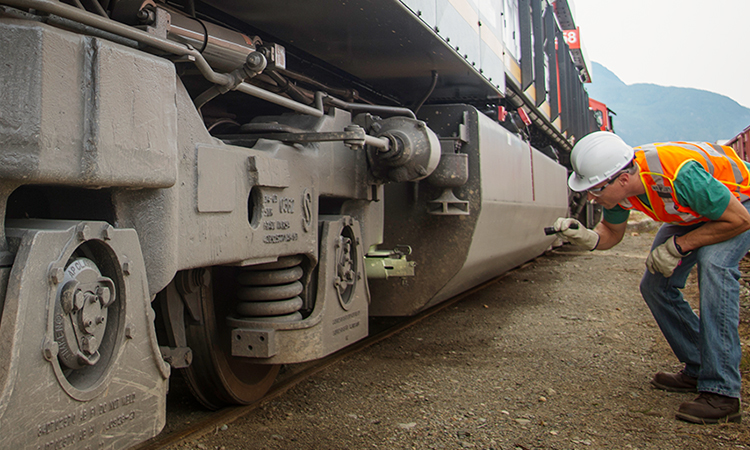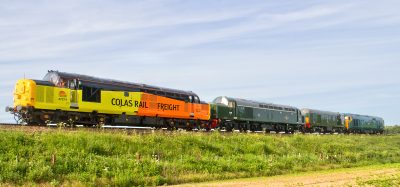Revised rules will improve the safety of Canada’s railways
Posted: 16 June 2021 | Stephanie Lines | No comments yet
For Global Railway Review, the Director of Operations Management in Rail Safety at Transport Canada, Stephanie Lines, details the latest revised safety measures demanded in the ‘Rules Respecting Key Trains and Key Routes’ that are due to come into force in summer 2021 to further heighten the safety of rail in Canada.


Credit: Transport Canada
In February 2016, following a series of derailments of trains carrying crude oil, Transport Canada approved the ‘Rules Respecting Key Trains and Key Routes’ (rules) under the Rail Safety Act. These rules introduced operational requirements that rail companies must follow, including speed restrictions for key trains, conducting more frequent track inspections and conducting risk assessments for key routes.
Following a series of derailments of trains carrying crude oil, Transport Canada approved the ‘Rules Respecting Key Trains and Key Routes’ under the Rail Safety Act”
In 2019 and 2020, additional safety measures were introduced through Ministerial Orders to further strengthen rail safety for the movement of dangerous goods by rail. To make these additional safety measures permanent, on 1 April 2020, the Minister of Transport issued a Ministerial Order requiring railway companies to revise the ‘Rules Respecting Key Trains and Key Routes’ to ensure that the new safety measures that were introduced are reflected in the rules.
On 22 February 2021, revisions to the ‘Rules Respecting Key Trains and Key Routes’ included several changes which address risk factors for derailments caused by railway infrastructure. The revisions improve operational performance and update current railway practices by introducing new requirements that ensure an increased level of safety when the rail infrastructure is most vulnerable: during the winter season.
New definitions
The revised rules introduce a ‘higher risk key train’, which is defined as a key train carrying crude oil or liquefied petroleum gases in a continuous block of 20 or more tank cars or 35 or more cars dispersed throughout the train.
Quick facts
- A key train carries one or more tank cars of dangerous goods that are toxic by inhalation, or carries 20 or more tank cars of dangerous goods
- A key route carries more than 10,000 carloads of dangerous goods per year
- Following two derailments of crude oil trains in Saskatchewan in December 2019 and February 2020, Transport Canada issued a series of Ministerial Orders to the railway companies to strengthen their track inspection practices and to reduce speeds for trains carrying crude oil and liquefied petroleum gas
- In early March 2021, Transport Canada Minister, Omar Alghabra, issued two Ministerial Orders under the Railway Safety Act to put in place the right conditions to address the uncontrolled movement of railway equipment.
New requirements for a Winter Operational Risk Mitigation Plan
The purpose of the Winter Operation Risk Mitigation Plan is to ensure that companies take additional measures to manage the specific risks to the integrity of the rail during colder periods”
Research and field experience has demonstrated that railway tracks are more prone to failure in the winter months due to material behaviour at a lower temperature. The purpose of the Winter Operation Risk Mitigation Plan is to ensure that companies take additional measures, specific to each subdivision where higher risk key trains operate, to manage the specific risks to the integrity of the rail during colder periods.
The revised rules require that the Winter Operation Risk Mitigation Plan must:
- Be approved by a professional engineer
- Define a minimum number of rail flaw tests during the winter period
- Define criteria for additional visual inspections during the winter period
- Prescribe broken rail detection technology in non-signalled territory, and require immediate follow up when a broken rail is detected
- Be filed with Transport Canada to ensure that risks associated with winter weather are appropriately identified and addressed.
New speed restrictions
The revised rules impose further limits on operating speeds for key trains, which may not exceed 50mph when outside what Statistic Canada defines as a ‘census metropolitan area’ (CMA) and are limited to 35mph inside a CMA.
The speed restrictions for higher risk key train are based on:
- Temperatures with a Winter Operation Risk Mitigation Plan
- Time of year (15 November to 14 March) without a Winter Operation Risk Mitigation Plan.
With a Winter Operational Plan, higher risk key trains are limited to between 40 and 50mph outside a CMA, and to between 25 and 30mph inside a CMA, depending on ambient temperature and whether trains are operating on signalled or non-signalled track.
New procedures dealing with the safety of infrastructure on key routes
New requirements on enhanced track inspections require railway companies that operate key routes to ensure that a replacement rail is ultrasonically tested prior to trains operating over it. In the event that ultrasonic testing cannot be done, speed restrictions must be approved by a professional engineer and implemented over the replacement rail. Record keeping requirements for the testing and installation of the replacement rail must also be adhered to.
The amended ‘Rules Respecting Key Trains and Key Routes’ provide enhanced requirements relevant to important parameters affecting rail safety”
Likewise, railway companies that operate key routes will be required to develop a continuous welded rail (CWR) joint management plan to ensure the optimal condition of CWR joints. The plan, subject to professional engineer approval, must include a joint maintenance and inspection schedule. Under this new requirement, railways must also provide an annual report to Transport Canada that details the number and location of temporary joints in CWR.
The amended ‘Rules Respecting Key Trains and Key Routes’ provide enhanced requirements relevant to important parameters affecting rail safety. The changes to the rules will come into force on 22 August 2021 and will impact federally regulated railway companies.
Making changes to the ‘Rules Respecting Key Trains and Key Routes’ is an example of the many steps that Transport Canada continues to take to strengthen rail safety and to prevent derailment and accidents resulting from infrastructure failure. Transport Canada remains committed to safeguarding all of the Canadians who live and work along rail lines by putting in place the necessary measures to reduce the risk of accidents.
Stephanie Lines is the Director of Operations Management in Rail Safety at Transport Canada and is responsible for regulatory oversight frameworks to verify compliance to the Railway Safety Act. She has worked at Transport Canada since 2010 and was previously the Director of Motor Vehicle Regulation Enforcement.
Related topics
Adverse Weather, Cargo, Freight & Heavy-Haul, Infrastructure Developments, Operational Performance, Regulation & Legislation, Safety, The Workforce, Track/Infrastructure Maintenance & Engineering








